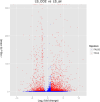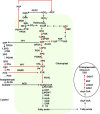Elevated CO2 improves lipid accumulation by increasing carbon metabolism in Chlorella sorokiniana
- PMID: 25973988
- PMCID: PMC11389043
- DOI: 10.1111/pbi.12398
Elevated CO2 improves lipid accumulation by increasing carbon metabolism in Chlorella sorokiniana
Abstract
Supplying microalgae with extra CO2 is a promising means for improving lipid production. The molecular mechanisms involved in lipid accumulation under conditions of elevated CO2, however, remain to be fully elucidated. To understand how elevated CO2 improves lipid production, we performed sequencing of Chlorella sorokiniana LS-2 cellular transcripts during growth and compared transcriptional dynamics of genes involved in carbon flow from CO2 to triacylglycerol. These analyses identified the majority genes of carbohydrate metabolism and lipid biosynthesis pathways in C. sorokiniana LS-2. Under high doses of CO2 , despite down-regulation of most de novo fatty acid biosynthesis genes, genes involved in carbohydrate metabolic pathways including carbon fixation, chloroplastic glycolysis, components of the pyruvate dehydrogenase complex (PDHC) and chloroplastic membrane transporters were upexpressed at the prolonged lipid accumulation phase. The data indicate that lipid production is largely independent of de novo fatty acid synthesis. Elevated CO2 might push cells to channel photosynthetic carbon precursors into fatty acid synthesis pathways, resulting in an increase of overall triacylglycerol generation. In support of this notion, genes involved in triacylglycerol biosynthesis were substantially up-regulated. Thus, elevated CO2 may influence regulatory dynamics and result in increased carbon flow to triacylglycerol, thereby providing a feasible approach to increase lipid production in microalgae.
Keywords: Chlorella sorokiniana; carbon dioxide; carbon flow; lipid; photosynthesis; transcriptomics.
© 2015 Society for Experimental Biology, Association of Applied Biologists and John Wiley & Sons Ltd.
Conflict of interest statement
The authors declare that they do not have any conflict of interest.
Figures







Similar articles
-
Enhanced lipid accumulation of photoautotrophic microalgae by high-dose CO2 mimics a heterotrophic characterization.World J Microbiol Biotechnol. 2016 Jan;32(1):9. doi: 10.1007/s11274-015-1963-6. Epub 2015 Dec 28. World J Microbiol Biotechnol. 2016. PMID: 26712624
-
Impacts of CO2 concentration on growth, lipid accumulation, and carbon-concentrating-mechanism-related gene expression in oleaginous Chlorella.Appl Microbiol Biotechnol. 2015 Mar;99(5):2451-62. doi: 10.1007/s00253-015-6397-4. Epub 2015 Jan 27. Appl Microbiol Biotechnol. 2015. PMID: 25620370
-
Physiological and Genetic Regulation for High Lipid Accumulation by Chlorella sorokiniana Strains from Different Environments of an Arctic Glacier, Desert, and Temperate Lake under Nitrogen Deprivation Conditions.Microbiol Spectr. 2022 Oct 26;10(5):e0039422. doi: 10.1128/spectrum.00394-22. Epub 2022 Oct 6. Microbiol Spectr. 2022. PMID: 36200894 Free PMC article.
-
Light, CO2, and carbon storage in microalgae.Curr Opin Plant Biol. 2025 Apr;84:102696. doi: 10.1016/j.pbi.2025.102696. Epub 2025 Feb 20. Curr Opin Plant Biol. 2025. PMID: 39983365 Review.
-
Transcriptional control in microalgae: co-regulated fatty acid biosynthesis and carbon dioxide fixation.Crit Rev Biotechnol. 2025 Jun 3:1-22. doi: 10.1080/07388551.2025.2503788. Online ahead of print. Crit Rev Biotechnol. 2025. PMID: 40462417 Review.
Cited by
-
Use of De Novo Transcriptome Libraries to Characterize a Novel Oleaginous Marine Chlorella Species during the Accumulation of Triacylglycerols.PLoS One. 2016 Feb 3;11(2):e0147527. doi: 10.1371/journal.pone.0147527. eCollection 2016. PLoS One. 2016. PMID: 26840425 Free PMC article.
-
A multi-parametric screening platform for photosynthetic trait characterization of microalgae and cyanobacteria under inorganic carbon limitation.PLoS One. 2020 Jul 23;15(7):e0236188. doi: 10.1371/journal.pone.0236188. eCollection 2020. PLoS One. 2020. PMID: 32701995 Free PMC article.
-
Effects of Valine and Urea on Carbon and Nitrogen Accumulation and Lignin Content in Peach Trees.Plants (Basel). 2023 Apr 10;12(8):1596. doi: 10.3390/plants12081596. Plants (Basel). 2023. PMID: 37111820 Free PMC article.
-
Molecular basis of autotrophic vs mixotrophic growth in Chlorella sorokiniana.Sci Rep. 2018 Apr 24;8(1):6465. doi: 10.1038/s41598-018-24979-8. Sci Rep. 2018. PMID: 29691462 Free PMC article.
-
De novo transcriptome and lipidome analysis of Desmodesmus abundans under model flue gas reveals adaptive changes after ten years of acclimation to high CO2.PLoS One. 2024 May 17;19(5):e0299780. doi: 10.1371/journal.pone.0299780. eCollection 2024. PLoS One. 2024. PMID: 38758755 Free PMC article.
References
-
- Adamson, S.R. , James, A. , Robinson, J.A. and Stevenson, K.J. (1984) Inhibition of pyruvate dehydrogenase multienzyme complex from Escherichia coli with a radiolabeled bifunctional arsenoxide:evidence for an essential histidine residue at the active site of lipoam ide dehydrogenase? Biochemistry, 23, 1269–1274. - PubMed
-
- Amaro, H.M. , Guedes, A. and Malcata, F.X. (2011) Advances and perspectives in using microalgae to produce biodiesel. Appl. Energy, 88, 3402–3410.
-
- Beer, L.L. , Boyd, E.S. , Peters, J.W. and Posewitz, M.C. (2009) Engineering algae for biohydrogen and biofuel production. Curr. Opin. Biotechnol. 20, 264–271. - PubMed
-
- Chang, K.S. , Jeon, H. , Gu, M.B. , Pack, S.P. and Jin, E. (2013) Conversion of carbon dioxide to oxaloacetate using integrated carbonic anhydrase and phosphoenolpyruvate carboxylase. Bioprocess Biosyst. Eng. 36, 1923–1928. - PubMed
-
- Cheng, H. , Isoda, F. , Belsham, D.D. and Mobbs, C.V. (2008) Inhibition of agouti‐related peptide expression by glucose in a clonal hypothalamic neuronal cell line is mediated by glycolysis, not oxidative phosphorylation. Endocrinology, 149, 703–710. - PubMed
Publication types
MeSH terms
Substances
LinkOut - more resources
Full Text Sources
Molecular Biology Databases

